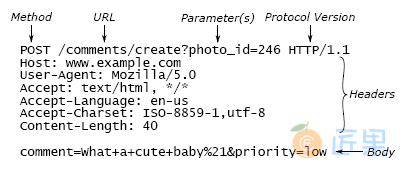为了说明信息隐藏中的问题,让我们考虑由学生在软件设计课程中实现 HTTP 协议的设计决策。看到他们做得好的事情以及遇到问题的地方都是很有用的。
HTTP 是 Web 浏览器用来与 Web 服务器通信的机制。当用户单击 Web 浏览器中的链接或提交表单时,浏览器使用 HTTP 通过网络将请求发送到 Web 服务器。服务器处理完请求后,会将响应发送回浏览器。该响应通常包含要显示的新网页。HTTP 协议指定了请求和响应的格式,两者均以文本形式表示。图 5.1 显示了描述表单提交的 HTTP 请求示例。要求课程中的学生实施一门或多门课程,以使 Web 服务器可以轻松地接收传入的 HTTP 请求并发送响应。
图 5.1:HTTP 协议中的 POST 请求包含通过 TCP 套接字发送的文本。每个请求都包含一个初始行,一个由空行终止的标头集合以及一个可选主体。初始行包含请求类型(POST 用于提交表单数据),指示操作(/注释/创建)和可选参数的 URL(photo_id 的值为 246)以及发送者使用的 HTTP 协议版本。每个标题行由一个名称(例如 Content-Length)及其后的值组成。对于此请求,正文包含其他参数(注释和优先级)。
To illustrate the issues in information hiding, let’s consider the design decisions made by students implementing the HTTP protocol in a software design course. It’s useful to see both the things they did well and they areas where they had problems.
HTTP is a mechanism used by Web browsers to communicate with Web servers. When a user clicks on a link in a Web browser or submits a form, the browser uses HTTP to send a request over the network to a Web server. Once the server has processed the request, it sends a response back to the browser; the response normally contains a new Web page to display. The HTTP protocol specifies the format of requests and responses, both of which are represented textually. Figure 5.1 shows a sample HTTP request describing a form submission. The students in the course were asked to implement one or more classes to make it easy for Web servers to receive incoming HTTP requests and send responses.
Figure 5.1: A POST request in the HTTP protocol consists of text sent over a TCP socket. Each request contains an initial line, a collection of headers terminated by an empty line, and an optional body. The initial line contains the request type (POST is used for submitting form data), a URL indicating an operation (/comments/create) and optional parameters (photo_id has the value 246), and the HTTP protocol version used by the sender. Each header line consists of a name such as Content-Length followed by its value. For this request, the body contains additional parameters (comment and priority).
